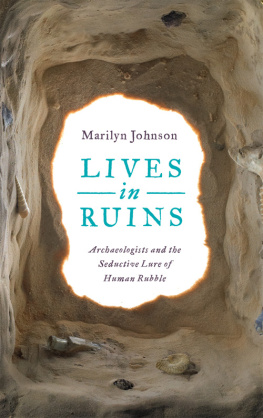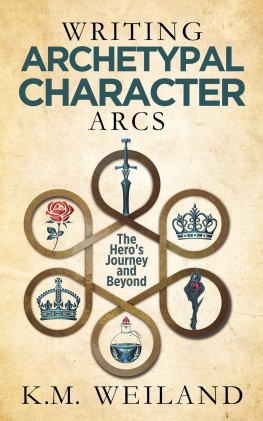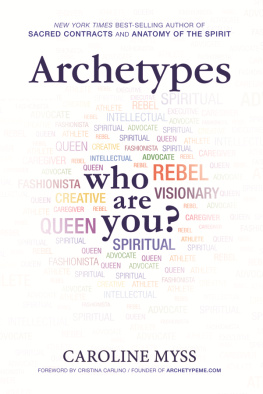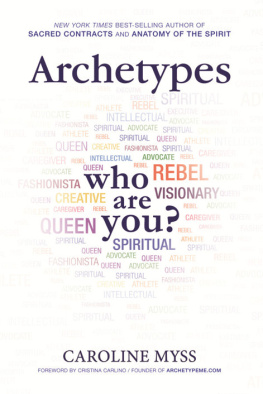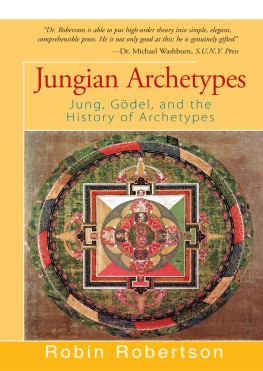THE
Power
OF
Archetypes
THE
Power
OF
Archetypes
How to Use Universal Symbols to Understand Your Behavior and Reprogram Your Subconscious
MARIE D. JONES

Copyright 2017 by Marie D. Jones
All rights reserved under the Pan-American and International Copyright Conventions. This book may not be reproduced, in whole or in part, in any form or by any means electronic or mechanical, including photocopying, recording, or by any information storage and retrieval system now known or hereafter invented, without written permission from the publisher, The Career Press.
THE POWER OF ARCHETYPES
Edited by Roger Sheety
Typeset by Kara Kumpel
Cover design by Howard Grossman/12E Design
Cover image by agsandrew/depositphotos
Printed in the U.S.A.
To order this title, please call toll-free 1-800-CAREER-1 (NJ and Canada: 201-848-0310) to order using VISA or MasterCard, or for further information on books from Career Press.

The Career Press, Inc.
12 Parish Drive
Wayne, NJ 07470
www.careerpress.com
Library of Congress Cataloging-in-Publication Data
Dedicated to Max:
Hero, Warrior, Sage.
Until you make the unconscious conscious, it will direct your life and you will call it fate. Carl Jung
[acknowledgments]
I would like to thank my wonderful agent, Lisa Hagan of Lisa Hagan Literary Agency, for being my longtime champion, fearless word warrior, and amazing friend. I would also like to thank the entire staff at New Page Books, most notably Michael Pye and Laurie Pye, for allowing me to express my ideas on paper year after year. You guys are the best, every single one of you! Lauren, Gina, Jeff, Adam, Allison, Roger, Diana, and the entire crewyou make the coolest books a reality! I hope I didnt leave anyone out!
I must thank my friends and family for being so supportive and forgiving of how much time I spend writing, or thinking about writing, from my mom, Milly; sister, Angella; brother, John; and extended family (Dad in heaven!), and my good pals Wendy, Therese, Jan, and Stephanie for the great times and laughter that keep me sane! I also cherish the many readers and fans I have made through the years with my books, radio shows, television shows, and online via social networking. To the great friends I have met online, and to my colleagues and fellow writers everywhere, thanks for the constant inspiration! Without you guys, who would listen to me? Well...
The one person I wish to thank the most is my son, Max. He is the moon, stars, and sun all rolled together, and the perfect example of the archetypes of warrior, hero, and sage, with the occasional trickster sneaking in for good measure. Without Max, my own heros journey would be so much less meaningful.
[contents]
Introduction
Chapter 1: The Multilayered Mind
Chapter 2: Archetypes: The Language of Symbols
Chapter 3: Archetypes and Their Meanings
Chapter 4: Global Archetypes: Pop Culture, Politics, and the Collective World View
Chapter 5: Who Are You and Whats Your Story?
Chapter 6: Be This, Not That! Tools for Transformation
Chapter 7: Working With Guides, Symbols, and Dreams
Chapter 8: New Narrative, New You
Conclusion: Been There, Done That
Notes
Bibliography
Index
About the Author
[introduction]
All over the world, there are universal symbols understood by every culture, religion, class system, race, and creed. These symbols are powerful subconscious drivers of our understanding and perception of the world we live in and the forces we interact with, as well as who we are as individuals. The actual definition of the word archetype is an idea or original pattern/model from which all things of the same type are representations or copies. The ancient Greek root of the word is archein, meaning original, old, and typos meaning pattern, type, model. Thus, an archetype is an original pattern from which all other similar persons, objects, ideas, concepts, and themes are derived, copied, modeled, and emulated.
In Jungian psychology, an archetype is an inherent idea or mode of thought derived from the experience of the species/race and present in the individual and collective unconscious. Carl Gustav Jung, the famed psychologist, utilized these symbols as a means for understanding the path to personal enlightenment, the way the world works, the way the human psyche works, and how to empower, heal, or achieve goals and desires. There are human and animal archetypes; in fact, Jung once said there were as many archetypes as there are typical situations in life, that they constructed a type of formula for the functioning of the subconscious, and they have the distinct characteristic of showing up throughout human history in the same form, with the same meaning. He defined 12 in particular that played a large role in the development of our psyches and personalities.
An archetype is the same anywhere around the globe, no matter what culture, religion, geographical boundary, or language spoken, for it represents the language of the collective detached from the intellect and judgment of the conscious mind. Often, we dont even think about how we got to behave, act, and think the way we do or what molded our personalities until something happens, usually tragic, that makes us realize we are not happy, fulfilled expressions of our deepest selves. This is where archetypes can be an incredible learning tool.
Common archetypes include:
The Hero: sent on a quest to pursue his/her destiny. Comparative mythologist Joseph Campbell spoke and wrote extensively of the heros journey found in many great novels and movies, including Star Wars.
The Self: our individual persona seeking to become completely realized, usually via the heros journey.
The Shadow Self: our opposing, amoral, instinctual, and primitive side associated with the past.
Mentor: the main guide of the self on its journey.
The Persona: the masks we wear to show others and hide who we truly are.
Anima/Animus: our female and male psyches, roles, and desires.
God: the perfected self.
Goddess: Mother Earth.
Trickster: the change agent.
Beast: the primitive past of humanity.
Sage: the wise ones among us.
Mother: the nurturer.
Father: the protector.
Wizard: the one who knows how to transform and who has hidden knowledge we seek.
The Fool: our confused, faulty self.
Scapegoat: the one we assign blame to.
These are just a sampling of the many archetypes we may already be familiar with, including the enemy/adversary/Devil, who often stands in the way of the hero achieving his/her mission and, thus, destiny. Because Jungian archetypes are often used to help understand a spiritual and hidden dimension to our existence, they can also help to explain a layout of that dimension, and give us insight and guidance as to how to overcome any obstacles or blocks we face on our journey. But Jung was not the only person to develop a list of archetypes. We now have so many others to work with who can help empower us in ways even Jung may not have imagined, all existing in the deepest parts of who we are as human beings.
Jung posited that the collective unconscious was akin to a storehouse of information, myths, stories, and symbols that all humans have access to, and is a necessary part of the human psyche. Especially during times of conflict, the collective unconscious can be tapped into for wisdom, guidance, and understanding, and also may be the realm of angels, spirits, demons, and other guardians and helpers that exist apart from our manifest reality, such as the spirit guides visited by shamans during their drumming journeys.
Next page

